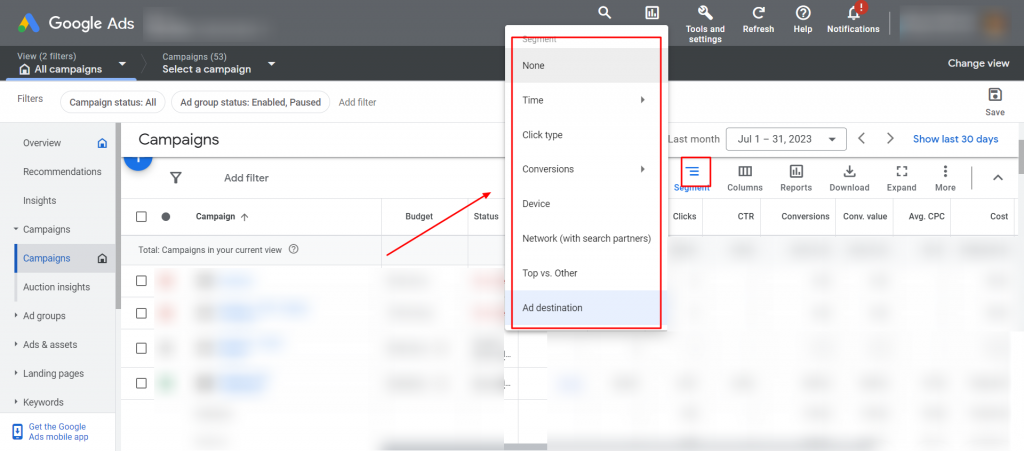Segments in Google Ads are crucial for refining your advertising strategy. This granular data it provides empowers advertisers to make informed decisions, optimize targeting, and maximize ROI by tailoring your approach to various audience segments.
How do segments contribute to Google Ads optimization?
In Google Ads, segment helps in categorizing your data to gain insights and analyze the performance of your campaigns. By using segments, you can examine different aspects of your campaign performance and make informed decisions to optimize your advertising strategy. Segments can be implemented at various levels within your Google Ads account, encompassing campaigns, ad groups, ads, keywords, and other elements.
It breaks down your data into smaller, more specific groups based on various dimensions or attributes. These subsets allow you to analyze and understand your campaign’s performance from various angles, helping you make informed decisions and optimizations.
Which segments are offered within Google Ads?
Segments provide a deeper level of insight into how different factors influence your advertising results. Some common segments in Google Ads include:
Time: By utilizing time-based segments, you can dissect performance trends within distinct time frames, including day, week, month, or even specific hours of the day. This can help you identify optimal times for running your ads or evaluate the impact of seasonal variations.
Device: Through this segment, you gain insights into the performance of your ads across various devices, such as desktop computers, mobile devices, and tablets. By delving into device-specific data, you can enhance campaign optimization for particular device categories and make bid adjustments as needed.
Network: By segmenting your data based on network, you can assess the performance of your ads on different platforms like the Google Search Network or the Google Display Network. This helps you understand where your ads are generating the best results and allocate your budget effectively.
Location: Segmenting data by location enables you to evaluate the performance of your campaigns across different geographical locations. This can help you identify areas where your ads are most effective and target specific locations more efficiently.
Conversion: Segments pertaining to conversions offer valuable insights into how your campaigns are performing in relation to particular conversion actions. These actions encompass purchases, form submissions, and newsletter sign-ups, allowing you to gauge the effectiveness of your efforts more precisely. This allows you to measure the effectiveness of your ads in driving desired actions.
Ad Destination: The “Ad Destination” segment allows you to analyze the performance of different types of clicks based on where users are taken after clicking on your ads. It provides insights into the effectiveness of your landing pages and user experience.
Top vs Other: The “Top vs Other” segment allows you to analyze how your ads perform in the top positions of the search results page (above the organic search results) versus how they perform in other positions (typically below the organic results).
Click Type: This segment categorizes interactions based on the type of click they represent. It provides a breakdown of the different ways users interact with your ads.
Why should you use segment?
Here’s why you should dive into the world of segments:
- Precision Targeting: Segments empower you to slice and dice your audience based on specific attributes like location, device, and time. This laser-focused targeting ensures that your ads reach the right people at the right moment, maximizing the chances of conversion.
- Customized Messaging: Tailoring your ad messaging for different segments allows you to speak directly to your audience’s needs and preferences. This personal touch resonates better, driving higher engagement and building stronger connections with potential customers.
- Budget Optimization: By identifying high-performing segments, you can allocate your budget more efficiently. This means you’re investing your resources where they have the most impact, reducing wastage and boosting ROI.
- Performance Enhancement: Testing different segments allows you to experiment and refine your approach. You can learn what works best for different groups and continuously optimize your campaigns for better performance.
- Stay Competitive: In the ever-evolving digital landscape, staying ahead means staying relevant. Utilizing segments keeps your campaigns up-to-date and aligned with the changing behaviors and preferences of your audience.
- Maximized Results: Combining all the above benefits ultimately leads to one thing – superior results. When your targeting is precise, your messaging resonates, your budget is optimized, and your strategies are informed, you’re setting the stage for campaign success.
The top segments advertisers must try in Google Ads
1. “Top vs Other” Segment:
- Optimized Visibility: Helps allocate budgets effectively between top and other ad positions for better visibility.
- Enhanced ROI: Allows bid adjustments to prioritize high-converting top positions, maximizing return on investment.
2. “Device” Segment:
- Tailored Strategy: Enables customized ad experiences for different devices, improving user engagement and conversions.
- Budget Efficiency: Optimizes bids based on device performance, allocating resources where they generate the best results.
3. “Location” Segment:
- Local Relevance: Targets specific geographic areas with ads that resonate, increasing relevance and engagement.
- Cost Savings: Focuses on regions with higher potential, minimizing wastage of resources on less-relevant areas.
4. “Time of Day” Segment:
- Optimal Timing: Helps schedule ads during peak activity periods, reaching the audience when they’re most likely to engage.
- Improved Efficiency: Reduces ad exposure during low-activity times, saving budget for higher-impact periods.
5. “Click Type” Segment:
- Insightful Optimization: Identifies which ad elements generate the most clicks, informing ad content refinement.
- Enhanced User Experience: Allows tailoring ads based on the most engaging click types, improving user satisfaction.
Leveraging these segments empowers advertisers to fine-tune their campaigns, target the right audience at the right time, and achieve better results with their Google Ads initiatives.
Related Links:






Stop the wasted ad spend. Get more conversions from the same ad budget.
Our customers save over $16 Million per year on Google and Amazon Ads.